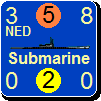Falken
Posts: 242
Joined: 8/8/2007
From: ON, Canada
Status: offline

|
Hi,
Little introduction.
I have been a massive supporter and fan of WITP. Bought WITP:AE in 2009 and still to this day, continue to have PBEM games. Bought the original game before that, and was a big fan of CHS and B-MOD. Anyway, all this to say that i've played a lot of wargames.
Back in 2014, I bought MWIF. To be honest, I bought it, read the manuals inside out, watched and did all the tutorials, and then didn't touch it for years. A lot has changed since the first 1.0 version, to the now pretty stable 3.0.2.
Recently, i've gone back into it, and thanks to AARs by rkr1958, composer99, and other fine AARs, I was able to get into it and understand the game process, and learn "how" to play this very detailed, and honestly, for me, quite complicated game. Yeah, I know,, funny to hear from a guy who plays a lot of WITP, but for some reason, I find this game way more complicated.
Gotta say,, i'm hooked. I've now bought the board game, and have a full Global War going on, now in Nov '39, using both the computer MWIF and the board game. I use the board game in unison for several reasons. 1) wanted to buy it to support ADG. 2) wanted to learn the board game differences and 3) I find that having the board game helps me in "seeing" the whole picture of what to do next.
While it's true that doing the computer moves, and then replicating the board moves takes 3-4 times longer, I just cannot get a feel for the overall war effort without "seeing it" on the boards. Just can't get a good sense from the screens (and yes, even with global map).
Anyway,, to stop rambling, and get to the point. I do not understand, at all, the whole process for Neutrality Pacts, including the offensive and defensive markers, and how the process works. Don't understand what the numbers mean, and why I would choose def or off markers when i'm germany or ussr.
Yes... I have the read the manual, but just don't get it. I've also done a search on these boards
Is there a tutorial or some AAR that might have gone through it so that I could learn from it? I don't know why, but i'm having a heck of a hard time understanding this process. It's the only part of the game, so far, where I just chose markers, and just put them in off or def as I have no idea what it does.
Wanted to ask before I get too far. Thanks everyone...
< Message edited by Falken -- 8/24/2020 11:44:33 PM >
|
 Printable Version
Printable Version











 New Messages
New Messages No New Messages
No New Messages Hot Topic w/ New Messages
Hot Topic w/ New Messages Hot Topic w/o New Messages
Hot Topic w/o New Messages Locked w/ New Messages
Locked w/ New Messages Locked w/o New Messages
Locked w/o New Messages Post New Thread
Post New Thread